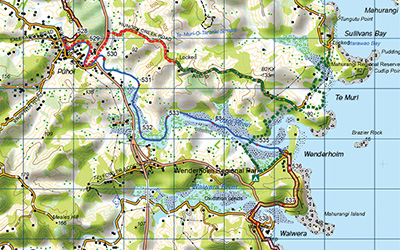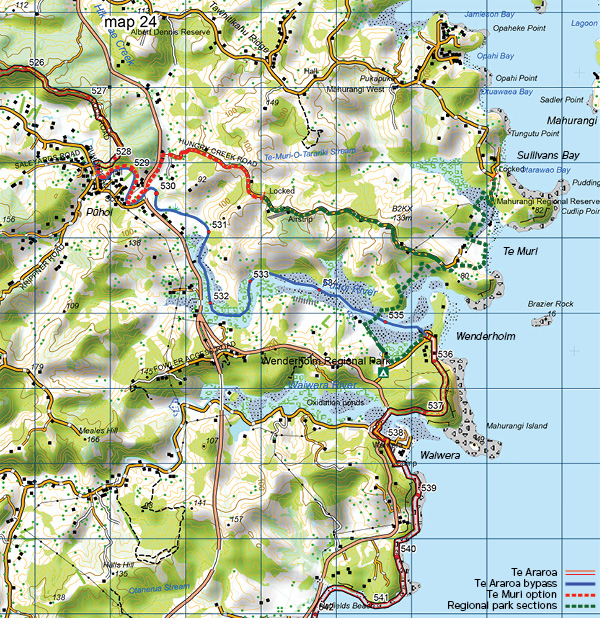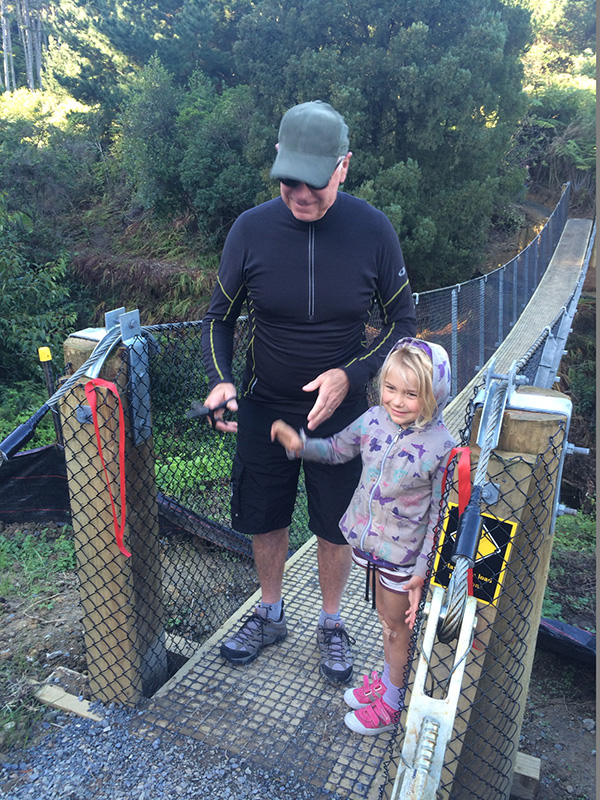$15 million Te Muri purchase lucky Te Araroa break

Updated 10 July 2015

Lucky Break: Stymied in its plans to run the national walkway along the south bank of the Pūhoi River, Te Araroa Trust could take advantage of the purchase of Te Muri and to provide an even better walking route, through the heart of a 900-hectare regional park—and one that wasn’t dogged by State Highway 1 for two kilometres. Conceptual Te Muri option Mahurangi Magazine Underlying maps Te Araroa Trust
An additional argument has surfaced for the coastal trail.
Between Pūhoi and Wenderholm, it was planned that Te Araroa should follow the south bank of the Pūhoi River. However, that plan unravelled when a property holder along the route refused to allow access. And because the riparian rights enjoyed by the property in question run all the way out to the river channel, the section can’t be by-passed by the likes of a boardwalk.
As regrettable as it is for the national walkway to be thwarted in this way, the property holder’s intransigence might yet result in a significantly improved route being adopted, and a correspondingly strengthened case for the Mahurangi Coastal Trail. Since the Pūhoi–Wenderholm section was mapped, the Auckland Regional Council purchased the 407-hectare property that bounds the north bank of the Pūhoi River for three kilometres before joining the coastal Te Muri parkland acquired in 1973. But rather than attempt to switch Te Araroa to the north bank of the river, the opportunity that the $15 million Te Muri purchase opens up is to route the national walkway through the heart of the property, along its fabulously scenic ridge farm road. As a ridge trail, this would form one of Te Araroa’s supreme highlights, not least of all because it connects to the splendidly isolated Te Muri Beach, where walkers can camp and break their long journey for a night or two.
From Remiger Road, turn southeast into Ahuroa Road and walk carefully, listening for and avoiding traffic, to the village of Pūhoi.

True Friend of Te Araroa: If complemented by the new Te Muri section proposed by Mahurangi Action, the Pūhoi River footbridge Sir Stephen Tindall is pictured opening here will allow walkers to reach the coast, 12.5 kilometres to the east, with the only road to cross being entirely optional—that leading to the legendary Pūhoi pub. image Tindall Foundation
Te Araroa Trust is trying to negotiate access on the other side of the river, but this is not yet concluded.
The suggested Te Muri route would also involve walkers using a public roadway: Hungry Creek Road. This two-kilometre road, because gets so little vehicular use, would make an entirely suitable section of Te Araroa. The same, only more so, applies to the three-kilometre scenic farm ridge road.
The regional parks, as magnificent a recreational asset as they are, mostly share a flaw that reflects the car-centric era in which they were conceived. For the vast majority of park users, a park visit begins and ends in a park car park. This is directly at odds with the draft Auckland Plan, which seeks to encourage more compact living to reduce the current over-dependency on private transport. The purchase of Te Muri presents the perfect opportunity to re-think the long-since unsustainable car-centric model. With Waiwera being the northern terminus of the metropolitan transport system, some 900 hectares of parkland can made accessible by the proposed Mahurangi Coastal Trail.
None of this is to suggest that the official Te Araroa bypass from Pūhoi to Wenderholm, the Pūhoi River, is a second-rate route. Aside from it being a superb alternative, tide permitting, it would form a classic round trip with Te Muri’s ridge road walk.
The $15 million, 407-hectare Te Muri purchase was not motivated by the goal of remedying shortcomings of Te Araroa. But provided that policymakers can be persuaded to see its potential, Te Muri could transform the Ahuroa–Waiwera section of Te Araroa from one of the sparser sections, to one of the richest.
May Te Muri bridge the otherwise unlucky break in Te Araroa.
Update Thanks to the philanthropy of Sir Stephen Tindall, since 16 May 2014, a footbridge spans the Pūhoi River, and a ridge track now replaces Pūhoi Road, as the official Te Araroa route.
